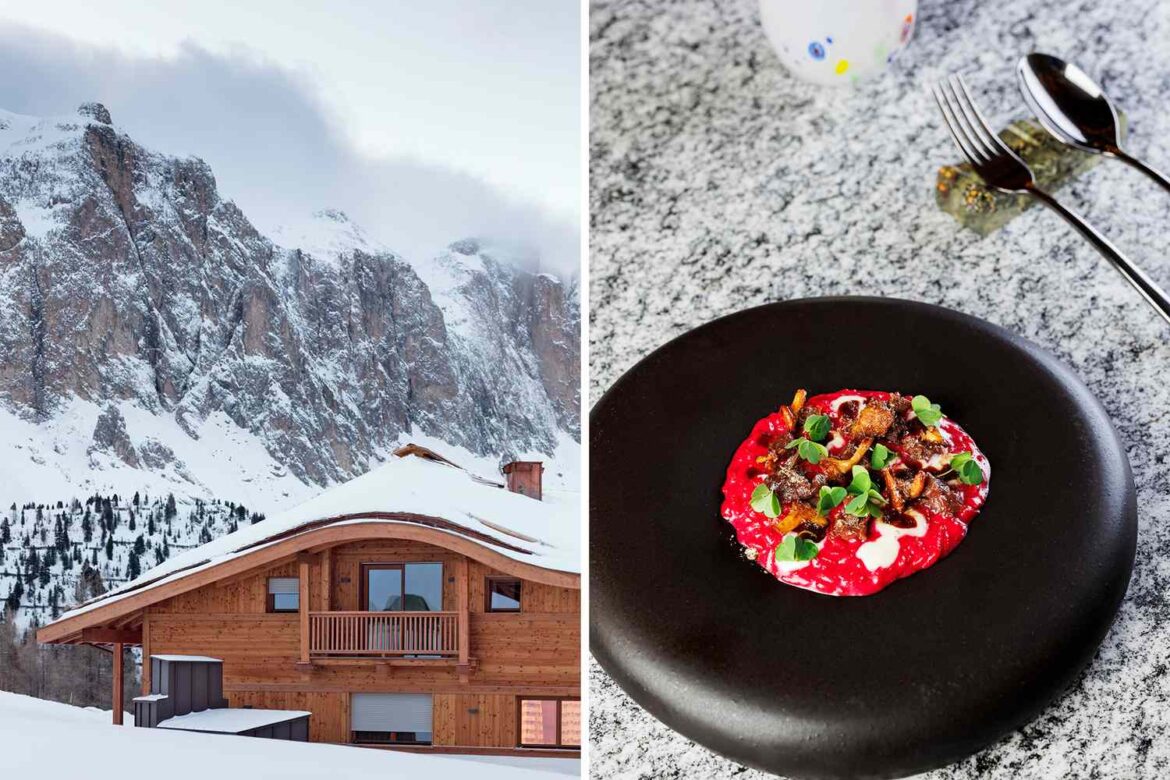“We might call it ‘mountain cuisine,’ ” explains Alessandro Gilmozzi, a celebrated chef from northern Italy’s Val di Fiemme. Italian Alpine food, he says, is defined by the challenges and gifts of high-elevation life—a dynamic he knows well, since he and his family have been cooks in the Dolomites for generations.
Their mountain cuisine is built on elemental processes, like fire and fermentation, and makes use of wild herbs, freshwater fish, game meats, and cheeses crafted in the malghe, the seasonal dairy farms that speckle the hillsides. It’s also shaped by the Ladin, the region’s minority ethnic group, who speak a language separate from Italian, and by the traditions of nearby Austria.
From left: Dried flowers in a window at El Brite de Larieto; the restaurant’s tagliatelle with sausage ragù.
From left: Valeria Bismar/El Brite de Larieto; Chantal Arnts/El Brite de Larieto
Unique dishes can be found in these small communities, including those hosting the events. From Cortina d’Ampezzo, the hub for mountain sports, comes casunziei all’Ampezzana—half-moon-shaped ravioli stuffed with turnips or beets and dressed in butter and poppy seeds. Snowboarding and freestyle skiing will be in Livigno, where buckwheat is used for manfrigole, crêpes filled with cheese and air-dried beef. Meanwhile, Bormio, which will host downhill skiing and ski mountaineering, is known for pizzoccheri, a buckwheat pasta. Here are five places to get a taste of the region.
Chalet Gerard
Helga Mussner has been cooking at this mountain lodge in Selva di Val Gardena ever since her husband, a former Olympic skier, opened it in 1964. Though there is now a new head chef, Mussner still comes in to make apple strudel every day. The restaurant was renovated in 2010, but retains its homey roots with dishes like crafuncins (rye-flour ravioli) and Italian-style goulash.
Al Peršéf
The name of this 20-seat restaurant inside the family-run Hotel Sporting, in Livigno, means “manger,” evoking the livestock huts and pastures visible through the windows. Chef Attilio Galli brings a light Japanese touch to two high-concept tasting menus—one inspired by local ingredients like rabbit, thistle, and wild hay, the other grounded in traditional recipes, like the milk-and-rice stew menestra da lecc, made with a hint of spruce.
El Brite de Larieto / Sanbrite
Chef Riccardo Gaspari and his wife, Ludovica Rubbini, operate two very different restaurants in Gaspari’s hometown of Cortina d’Ampezzo. El Brite de Larieto, an agriturismo first opened by Gaspari’s parents, serves rustic dishes like canederli (Italy’s version of a knödel, a hearty boiled dumpling common in Central Europe) and a fondue of their own farmstead cheese. The couple opened SanBrite in 2017, which went on to earn a Michelin star. Its refined dishes include spaghetti in an oil infused with mountain pine.
From left: Dessert at El Molin; dining in the barn at SanBrite.
From left: Stefano Caffarri; Chantal Arnts/SanBrite
Fana Ladina
At this 50-year-old restaurant set in a 17th-century farmhouse in San Vigilio di Marebbe, servers wear traditional Alpine dress. Chef Alma Willet’s menu is all about Ladin cuisine. There are elegant roasts and risottos, but her specialty is rib-sticking peasant fare, such as crafuns môri (savory doughnuts) topped with ragù and feies da sôni (fried sheets of potato dough) with cranberries and sauerkraut.
El Molin
Alessandro Gilmozzi is the longtime chef-owner of this Michelin-starred restaurant, which opened in 1990 inside a 17th-century millhouse in Cavalese. His tasting menu incorporates wild botanicals, including juniper, pine buds, and calendula, and uses preservation techniques like smoking and pickling, once essential for surviving harsh winters.


Dining and Cooking